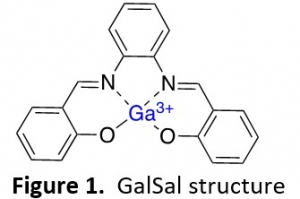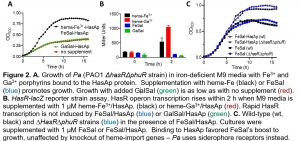Overview
Summary
Pseudomonas aeruginosa (Pa), a WHO priority 1 pathogen, causes life-threatening infections. Multidrug resistant Pa has been classified by the CDC as a “serious threat” to public health owing to its ability to overcome many current treatment strategies. It frequently causes infection in immunocompromised patients and a leading cause of nosocomial infections. Pa is the 2nd leading cause of ventilator associated pneumonias in intensive care facilities, and the primary cause of respiratory infection in cystic fibrosis patients. Iron is essential for Pa to survive in the host and previous investigators have attempted to regulate Pa infection by chelating iron. These attempts have generally shown low efficacy because of an abundance of iron can be found in the infected patients’ blood (heme). GalSal circumvents this issue by preventing Pa from using heme as an iron source. It accomplishes this by inhibiting Pa’s ability to sense heme and by regulating cellular transport of heme by Pa. In addition, gallium is electrochemically similar to iron and therefore competes with iron for uptake by Pa. Finally, GalSal is toxic to Pa and results in cellular death.
Market
The global antimicrobial market is continuously expanding driven by the increasing prevalence of multidrug-resistant bacterial infections and the urgent need for innovative solutions. The global antibiotics market, valued at USD 40.7 billion in 2020, is expected to expand at a compound annual growth rate (CAGR) of 4.5% from 2021 to 2028, driven by rising prevalence of infectious diseases and supportive government legislation . Pseudomonas aeruginosa infections, the specific target of this technology, are a serious public health threat due to their resistance to many current treatment strategies. Given the bacterium's ability to cause a wide range of infections, including sepsis, pneumonia, and urinary tract infections, the potential market for this technology is extensive.
Furthermore, the technology is particularly relevant in the cystic fibrosis community. P. aeruginosa is a leading cause of respiratory infections in cystic fibrosis patients, often persisting for decades and leading to life-threatening chronic infections. With the limited effectiveness of current treatment options, novel therapies targeting this bacterium are in high demand, making this technology a potentially significant addition to the market.
Technology
The technology involves the use of gallium-salophen compounds to inhibit the HasAp protein and the P. aeruginosa siderophore iron uptake system, both crucial for the bacterium's survival and pathogenicity. The compounds are designed with a specific structure, represented by formula (I), which allows flexibility in the substituents and hence the creation of different gallium-salophen compounds.
The gallium-salophen compounds can be administered to patients in the form of a pharmaceutical composition to treat or prevent a wide range of conditions. These include, but are not limited to, sepsis, meningitis, endocarditis, osteomyelitis, otitis media, sinusitis, pneumonia, chronic respiratory tract infection, urinary tract infection, severe burns, cystic fibrosis, and various bacterial infections.
 Additionally, the technology provides methods of treatment by inhibiting HasAp protein activity, the P. aeruginosa siderophore iron uptake system, or both in patients in need of such treatment. This approach offers a new way to combat these infections, particularly problematic in immunocompromised patients and those with cystic fibrosis.
Additionally, the technology provides methods of treatment by inhibiting HasAp protein activity, the P. aeruginosa siderophore iron uptake system, or both in patients in need of such treatment. This approach offers a new way to combat these infections, particularly problematic in immunocompromised patients and those with cystic fibrosis.
Contact Info
Office of Technology Transfer
620 W Lexington St., 4th Floor
Baltimore, MD 21201
Email: [email protected]
Phone: (410) 706-2380